Introduction
Teaching Methods for Science Subjects in Classrooms, Teaching science in classrooms requires more than just delivering facts. It involves inspiring curiosity and building critical thinking. Science subjects need interactive methods that promote observation, experimentation, and reasoning. Traditional approaches like lectures are still valuable. However, modern methods focus more on student participation. Teachers must use strategies that connect theory with practice. Furthermore, engaging methods help learners develop problem-solving skills. Effective teaching in science ensures that students not only understand concepts but also apply them in real life. Therefore, choosing the right teaching method is crucial. Science teaching should encourage discovery and foster lifelong learning. By combining traditional and innovative methods, educators can make science both exciting and meaningful. As a result, students are more motivated to learn and pursue scientific inquiry beyond the classroom walls.
Lecture Method in Science
The lecture method remains one of the oldest teaching techniques. In science classrooms, it is often used to introduce complex topics. Teachers explain key ideas in a structured manner. Moreover, lectures allow the delivery of a large amount of information within limited time. However, this method is more teacher-centered. Students may become passive listeners if lectures are not interactive. To overcome this, teachers can include short questions during explanations. Visual aids such as charts, diagrams, and slides can also enhance clarity. Furthermore, lectures work best when combined with other methods. For instance, after a lecture, students can perform related activities. This approach balances theory with application. Thus, while the lecture method is efficient, it must be adapted to engage learners. With effective use, it remains a valuable tool in science classrooms.
Demonstration Method
The demonstration method is widely used in teaching science subjects. In this approach, teachers perform experiments or show models. Students observe carefully and record outcomes. This method makes abstract concepts easier to understand. For example, demonstrating chemical reactions or physical laws builds strong visual connections. Moreover, demonstrations enhance student attention and interest. They also promote safety, as students learn proper procedures before practicing independently. However, the demonstration method has some limitations. It often requires specific equipment, materials, and preparation. Time management is also important to ensure that demonstrations do not dominate the lesson. Furthermore, teachers must encourage students to ask questions. This interaction deepens understanding. In conclusion, demonstration is an effective method that connects theory with practice. It is particularly useful in science classrooms where visualization strengthens learning outcomes.
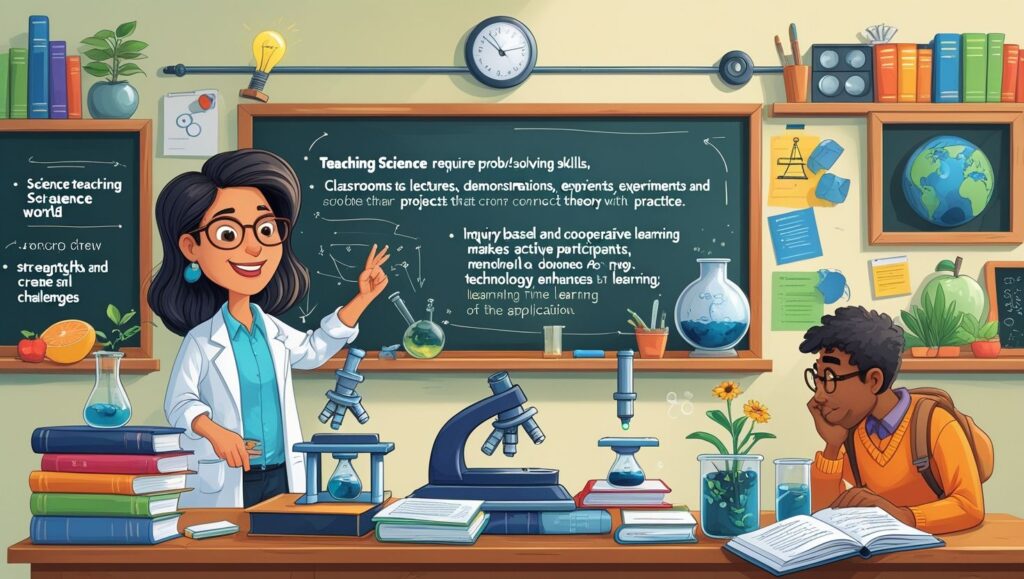
Inquiry-Based Learning
Inquiry-based learning emphasizes curiosity and problem-solving. In science classrooms, this method allows students to explore questions through investigation. Teachers act as facilitators rather than information providers. For example, students may design small experiments to test hypotheses. This method develops critical thinking and analytical skills. Furthermore, inquiry-based learning makes science more engaging and student-centered. Learners become active participants rather than passive recipients. Teachers guide students by providing resources, frameworks, and feedback. Additionally, this method encourages collaboration, as students often work in groups. However, it requires more time compared to traditional methods. Teachers must carefully design activities to match students’ abilities. Moreover, assessment in inquiry-based learning should focus on process as well as results. Overall, this method is effective in building scientific habits of mind. It nurtures creativity and prepares students for advanced learning.
Project-Based Learning
Project-based learning connects classroom knowledge with real-world applications. In science subjects, students work on projects that require research, planning, and experimentation. For example, they may build models, conduct surveys, or investigate environmental issues. This method encourages collaboration, as projects often involve teamwork. Furthermore, it develops essential skills like communication, problem-solving, and time management. Teachers act as mentors, guiding students through the process. Project-based learning also promotes long-term retention of knowledge. Because students are actively involved, they remember concepts more effectively. However, this method requires sufficient time and resources. Teachers must ensure that projects align with curriculum goals. Assessment can also be complex, as it involves both process and product. Nevertheless, project-based learning is highly effective in science classrooms. It bridges theory with practice and motivates students to apply scientific knowledge in real-life contexts.
Cooperative Learning in Science
Cooperative learning focuses on teamwork and peer interaction. In this method, students work in groups to solve problems or complete tasks. Science classrooms benefit greatly from this approach. For instance, students may collaborate to analyze experimental data or discuss scientific case studies. Cooperative learning promotes social skills, responsibility, and communication. Moreover, it encourages students to share different perspectives. Teachers play the role of facilitators, ensuring equal participation. This method also supports weaker students, as peers provide assistance. However, group activities must be carefully structured. Without proper guidance, some students may not contribute actively. Additionally, assessing individual performance in groups can be challenging. Nevertheless, cooperative learning creates an engaging environment. It motivates students to learn from one another. When applied effectively, it enhances both academic and social outcomes in science education.
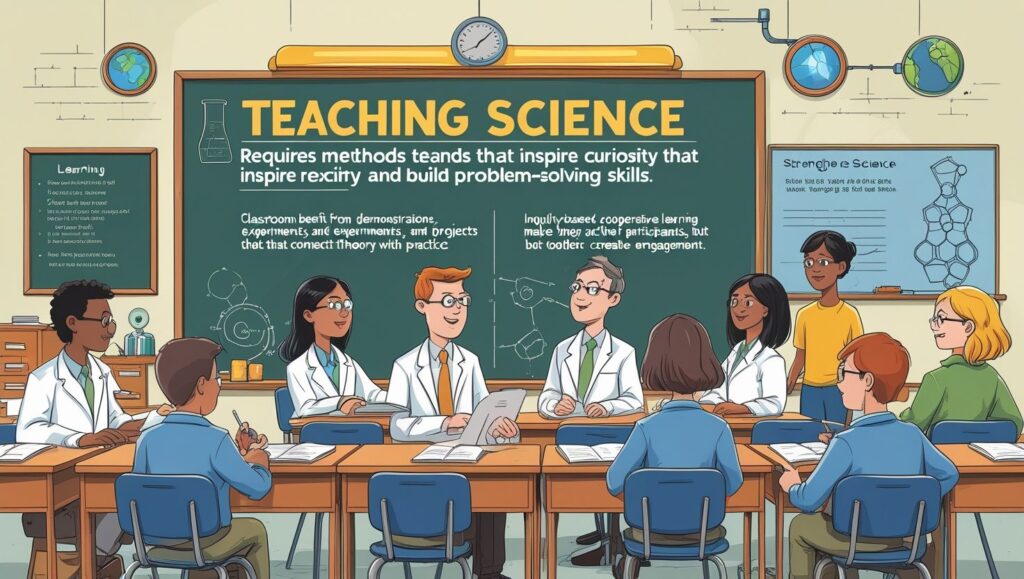
Use of Technology in Science Teaching
Modern classrooms rely increasingly on technology. In science subjects, digital tools have transformed teaching methods. Interactive simulations, virtual labs, and multimedia presentations make learning more engaging. For example, students can visualize atomic structures or perform virtual dissections. Online resources also provide access to updated scientific information. Furthermore, technology supports personalized learning, allowing students to learn at their own pace. Teachers can use educational apps to assess progress instantly. However, challenges include limited resources in some schools and the risk of over-reliance on technology. Teachers must balance digital tools with hands-on experiences. Additionally, training is necessary to use technology effectively. Despite these challenges, technology has great potential in science education. It connects learners to global knowledge and prepares them for a technology-driven world. Thus, integrating technology is essential for modern science teaching.
Experimental Method
The experimental method is central to science education. It allows students to test ideas and verify scientific principles. By conducting experiments, learners engage directly with the subject matter. This method develops observation, analysis, and problem-solving skills. For example, performing chemical reactions or measuring physical quantities provides firsthand experience. Furthermore, the experimental method fosters curiosity and independence. Students learn the importance of accuracy and careful documentation. However, it requires laboratory facilities, safety measures, and adequate time. Teachers must guide students to follow proper procedures and ensure safety. Moreover, experiments should match the level of learners to avoid confusion. Despite these challenges, the experimental method is highly effective. It transforms abstract theories into practical knowledge. By engaging in experiments, students build confidence and develop scientific attitudes. Therefore, this method is fundamental in teaching science subjects.
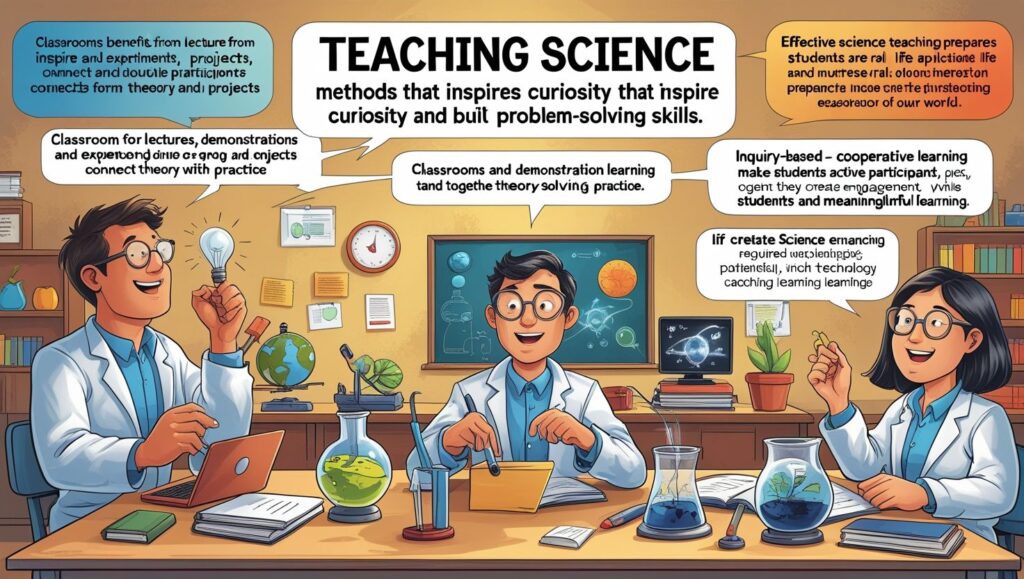
Problem-Solving Approach
The problem-solving approach is widely used in teaching science subjects. In this method, students are presented with scientific problems to solve. They apply knowledge, reasoning, and creativity to find solutions. For example, students may be asked to design an energy-efficient model or explain environmental issues. This approach promotes critical thinking and logical reasoning. Moreover, it encourages students to integrate concepts from different areas of science. Teachers act as facilitators, guiding students through the problem-solving process. Furthermore, this method prepares learners for real-life challenges. However, it may be time-consuming, and not all students adapt quickly. Teachers must carefully design problems to match students’ levels. Additionally, assessment should recognize both effort and accuracy. Despite challenges, the problem-solving approach enhances understanding and application of knowledge. It motivates students to think deeply and apply science to practical situations.
Conclusion
Teaching science subjects requires a balanced use of methods. No single approach can meet all learning needs. Traditional methods like lectures provide structure, while modern approaches encourage exploration and creativity. Demonstrations, experiments, and projects connect theory with practice. Technology further enhances learning opportunities. Moreover, cooperative and inquiry-based methods make classrooms more interactive. Teachers must adapt methods according to subject matter, resources, and student abilities. Effective teaching of science goes beyond delivering facts. It builds curiosity, problem-solving, and critical thinking. By combining various methods, educators can create an engaging learning environment. Furthermore, diverse teaching strategies prepare students for future challenges in science and technology. Ultimately, effective science teaching empowers learners to become active participants in discovery. It also nurtures a lifelong interest in exploring the wonders of science.
References
- Bransford, J., Brown, A., & Cocking, R. (2000). How People Learn: Brain, Mind, Experience, and School. National Academies Press.
- Bybee, R. (2013). The Case for STEM Education: Challenges and Opportunities. NSTA Press.
- Llewellyn, D. (2013). Teaching High School Science Through Inquiry and Argumentation. Corwin Press.
- Driver, R., & Bell, B. (1986). Students’ thinking and the learning of science: A constructivist view. School Science Review, 67(240), 443–456.
- National Research Council. (2012). A Framework for K-12 Science Education: Practices, Crosscutting Concepts, and Core Ideas. National Academies Press.
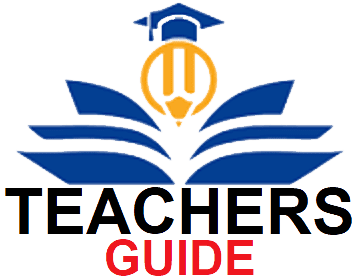
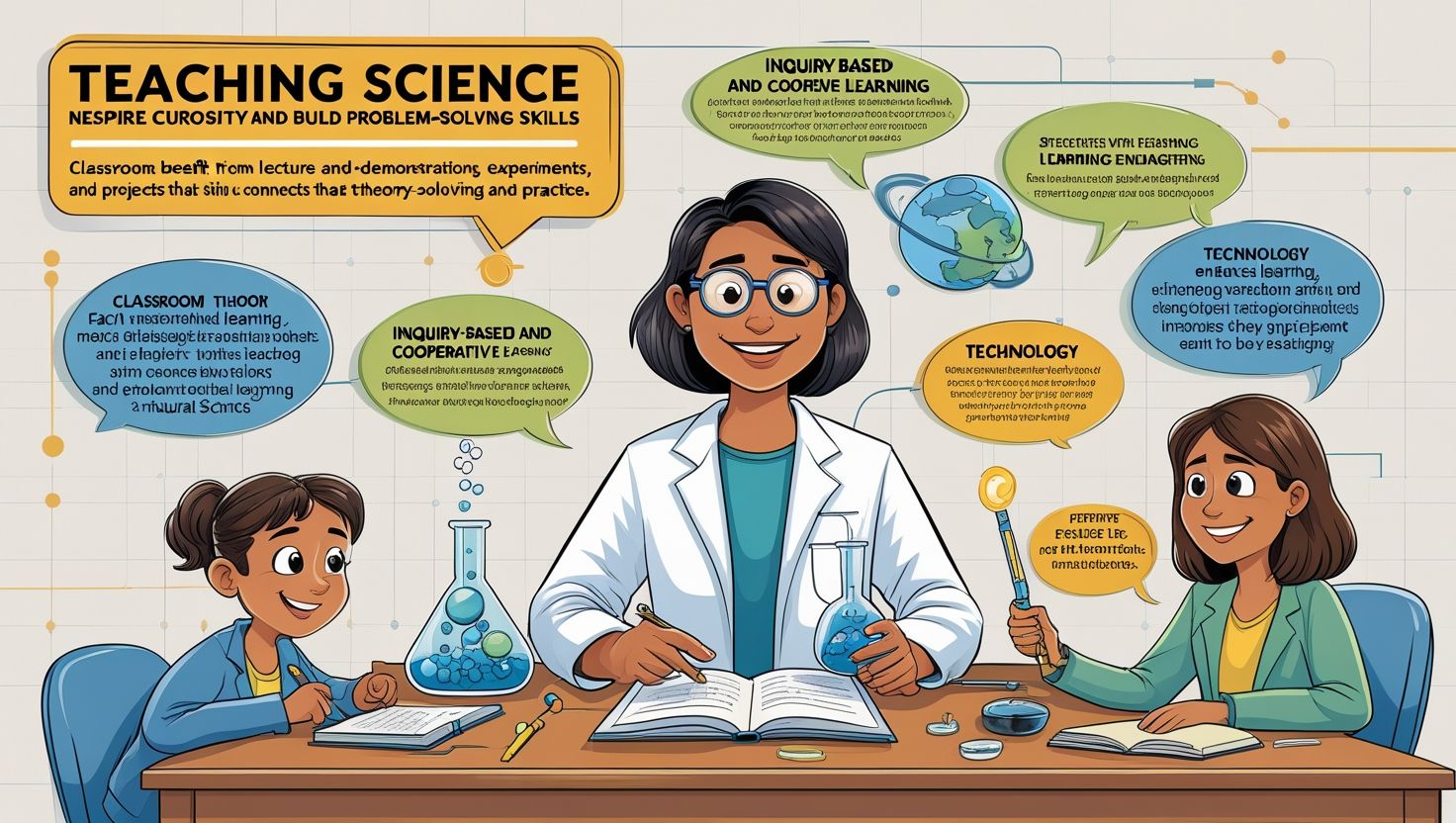
Excellent work! Looking forward to future posts.
Your tips are practical and easy to apply. Thanks a lot!
Thanks for addressing this topic—it’s so important.
This is one of the best explanations I’ve read on this topic.
Very relevant and timely content. Appreciate you sharing this.
Excellent work! Looking forward to future posts.
Your blog is a true hidden gem on the internet. Your thoughtful analysis and in-depth commentary set you apart from the crowd. Keep up the excellent work!
Thanks for addressing this topic—it’s so important.
This helped clarify a lot of questions I had.
This topic is usually confusing, but you made it simple to understand.
This was easy to follow, even for someone new like me.
This gave me a lot to think about. Thanks for sharing.
I love the clarity in your writing.
I wasn’t sure what to expect at first, but this turned out to be surprisingly useful. Thanks for taking the time to put this together.
Thanks for making this easy to understand even without a background in it.
I’ll be sharing this with a few friends.
You’ve sparked my interest in this topic.
I appreciate the depth and clarity of this post.
You’re doing a fantastic job with this blog.
su kaçak tespit cihazı Ümraniye’de yaşadığımız su kaçağı sorununu bu ekip sayesinde çözdük. Hızlı ve etkili bir hizmet. https://www.sonaydoo.com/read-blog/1722
What an engaging read! You kept me hooked from start to finish.
The way you write feels personal and authentic.
Your breakdown of the topic is so well thought out.
I really appreciate content like this—it’s clear, informative, and actually helpful. Definitely worth reading!
I love how practical and realistic your tips are.
I’ve bookmarked this post for future reference. Thanks again!
Very relevant and timely content. Appreciate you sharing this.
This is one of the best explanations I’ve read on this topic.
Your tips are practical and easy to apply. Thanks a lot!
I’ve bookmarked this post for future reference. Thanks again!
What I really liked is how easy this was to follow. Even for someone who’s not super tech-savvy, it made perfect sense.
Thanks for addressing this topic—it’s so important.
Your advice is exactly what I needed right now.
Thank you for putting this in a way that anyone can understand.
What I really liked is how easy this was to follow. Even for someone who’s not super tech-savvy, it made perfect sense.
Your tips are practical and easy to apply. Thanks a lot!
Keep writing! Your content is always so helpful.
This was a great reminder for me. Thanks for posting.
What an engaging read! You kept me hooked from start to finish.